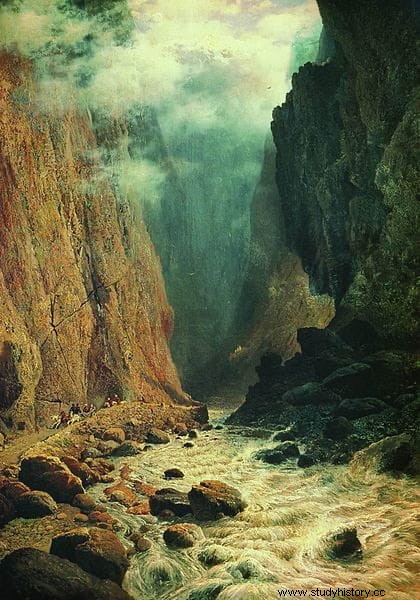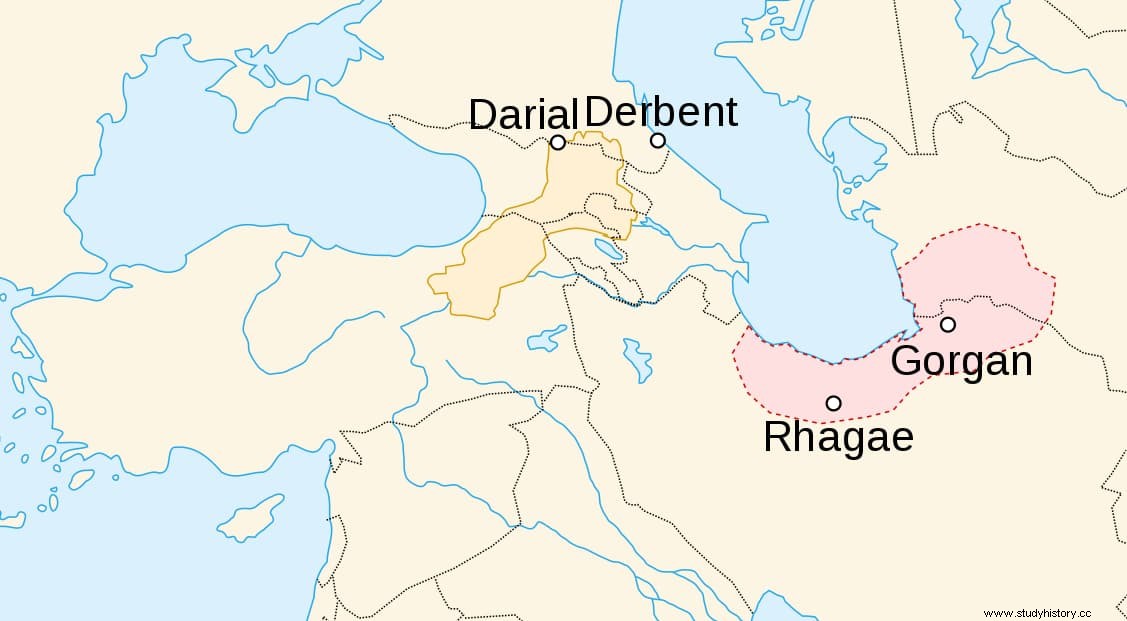Although they are also popularly known as Alexander's Gates , due to medieval literature (such as the Romance de Alexandre of the Pseudo-Callisthenes) who attributed its construction to the latter following Josephus, it is most likely that the Caspian Gates They were built during the 6th century, by the Sassanid dynasty.
Their goal was to block the southern passage through the Caucasus, keeping Anatolia and the Middle East safe from the barbarians from North. However, the exact location of the Gates is not known, so there are two places that are traditionally believed to have housed them.

The first is the Darial Gorge , a river gorge on the Russian-Georgian border through which the Terek River flows between Vladikavkaz and Tbilisi. Roman and Persian fortifications existed here from at least 150 B.C. known as Gates of Iberia (for the homonymous region), which Strabo called Porta Caucasica and Ptolemy Fortes Sarmatica .
They are identified with the Caspian Gates because the legendary tradition (also present in the Koran and the Bible with some variations) tells that Alexander the Great built iron gates here to contain the mythical people of Gog and Magog , which Flavius Josephus identified with the Scythians. Ruins of these ancient fortifications are still visible.
The other place is Derbent, a city in the south of the Russian Republic of Dagestan and on the border with Azerbaijan. It is traditionally considered the oldest city in the Russian Federation, with more than 5,000 years of history.

Precisely the city has a system of double walls with 30 towers, which go from the mountains to the sea, and a fortified citadel dating from Sassanid times. What's more, Derbent literally means closed door in Persian The Arabs knew her as Bāb al Abwab (Gate of gates), and for the Turks it was Demirkapı (Iron gate).
The fortress began to be built at the beginning of the 5th century AD. by the Sassanid emperor Khosroes I, and was later enlarged and improved by successive peoples who ruled it, such as Arabs, Mongols, and Russians. It is the oldest fortress in continuous use in history, with more than 1,000 years of uninterrupted use. Its walls are 20 meters high and 3 meters thick.

In addition, its Persian name began to be used between the end of the 5th century and the beginning of the 6th, at the time of the reign of the Sassanid Kavad I. The reason for such a name is that it is located in a narrow strip of three kilometers between the Caucasus and the Caspian Sea, which made it a strategic position that controlled the passage between the Eurasian steppes and the Middle East. And therefore also in the most suitable candidate to be the location of the legendary doors.
The Caspian Gates They are also mentioned in The Book of Wonders of Marco Polo, also citing the people of Gog and Magog but placing them north of Cathay (China). This leads some experts to believe that the legend of the Alexander gates they would be the attempt to explain, by Westerners, the stories that came from China about a great king building a great wall.

As we said before, the Koran also collects the legend. In sura 18 he refers to Dhul Qarnein, a character inspired by Alexander the Great, who would have built a wall to stop Gog and Magog, a people he identifies as the archetypal enemy of the chosen people . And in Sura 21 he says that on Judgment Day that wall will be reduced to dust , and then Gog and Magog will reappear for the last, apocalyptic battle. Luckily, the Derbent wall is still there.
Many other medieval legends have their origin in the gates of Alexander , like that of the red jews . In this sense, even in Los Viajes de Juan de Mandeville, the unique medieval best-seller that mixed and copied other people's works such as those of Marco Polo, Odorico and Haitón de Coricos, Gog and Magog are identified with the Ten Lost Tribes of Israel . But that's another story.
